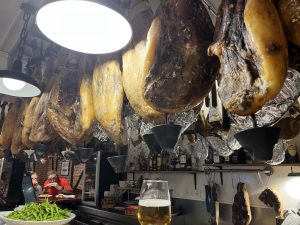After La Perla and our brief hike up Mount Urgull, we were ready for a night out, celebrating our trip and one of our party’s birthday. And what better place to celebrate than the Parte Vieja of Donostia? When I lived in Donostia, my friends and I spent quite a few nights wandering the bars, enjoying some drinks, and meeting some strange characters. Now was my chance to show the special charm, the unique marcha that only a night out in Donostia’s Parte Vieja can provide. It was a great night of family, friends, food, and fun!

- The Parte Vieja, or Parte or Alde Zaharra in Euskara, sits in the historic center of the city at the foot of Mount Urgull and is bounded to the east by the Urumea River. It was the urban center of the city, defined by the walls surrounding it, until about 1863. In fact, the whole of the Parte Vieja’s layout is relatively new, particularly considering that Donostia was founded in the 12th century. In 1813, the combined forces of Britain and Portugal, during their efforts to end the French occupation of the city, burned the old town to the ground. In addition to the two main churches and the San Telmo Convent, only a few buildings on a street now called August 31 Street (Abuztuaren 31 kalea), since the city was burned on that date, were unharmed.
- The walls that once surrounded the center were for the most part taken down in 1863, as the city was declared to no longer be a military fortress, allowing the city to expand. At the time, Donostia had about 15,000 inhabitants, 10,000 of which lived within those walls.
- The cornerstones of the Parte Vieja, which survived that 1813 fire, are the Santa María and San Vicente churches. San Vicente (San Bizente in Euskara), of gothic style, is the older – construction began in 1507. Santa Maria, a basilica, was constructed in 1738 with the support of the Royal Company of Caracas. However, the center of the Parte Vieja is Plaza de la Constitución. This is where the Tamborrada begins. Consti, as the locals call it, was originally a bullring, and you can still see the boxes where people would watch the bull fights from.
- The Parte Vieja, and by extension Donostia itself, is perhaps best known for its vibrant gastronomic scene, typified by the bars full of pintxos. Pintxos started in Donostia. The first was the Gilda, created when a bar owner stuck an anchovy, an olive and a chilli pepper with a toothpick. Donostia has the second most Michelin stars per capita in the world (only behind Kyoto, Japan) and several are in the Parte Vieja.
Primary Source: Parte Zaharra, Wikipedia


